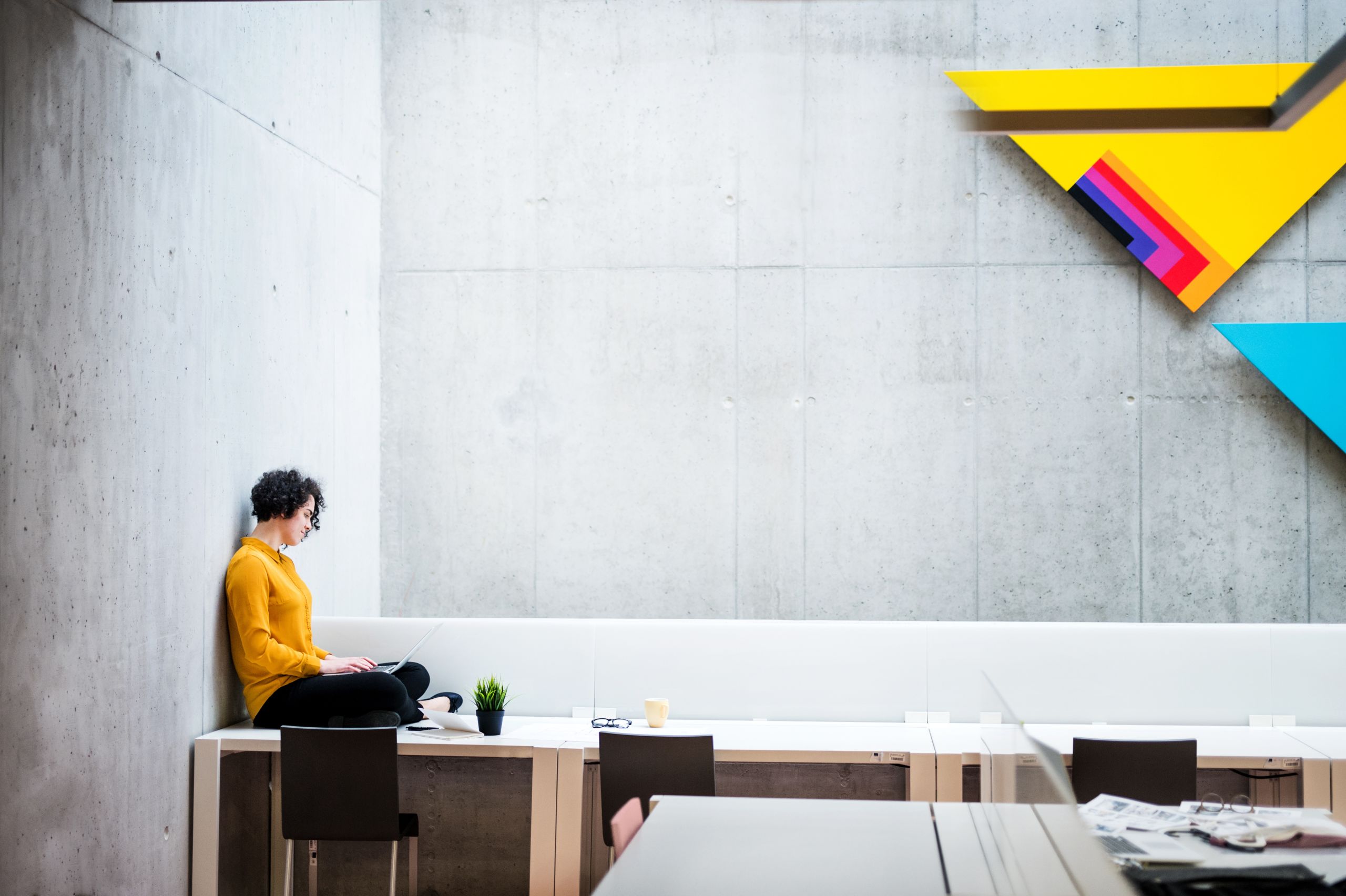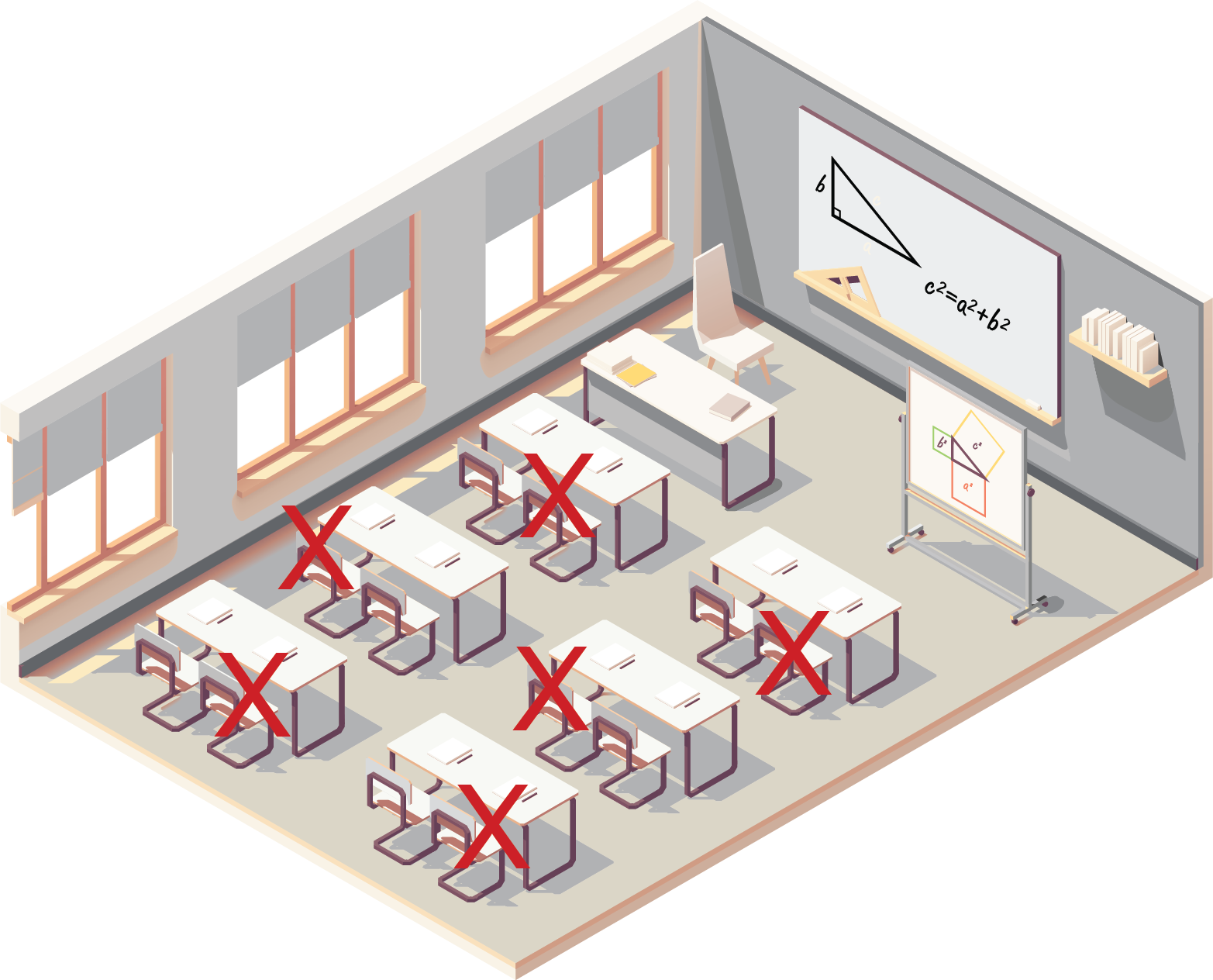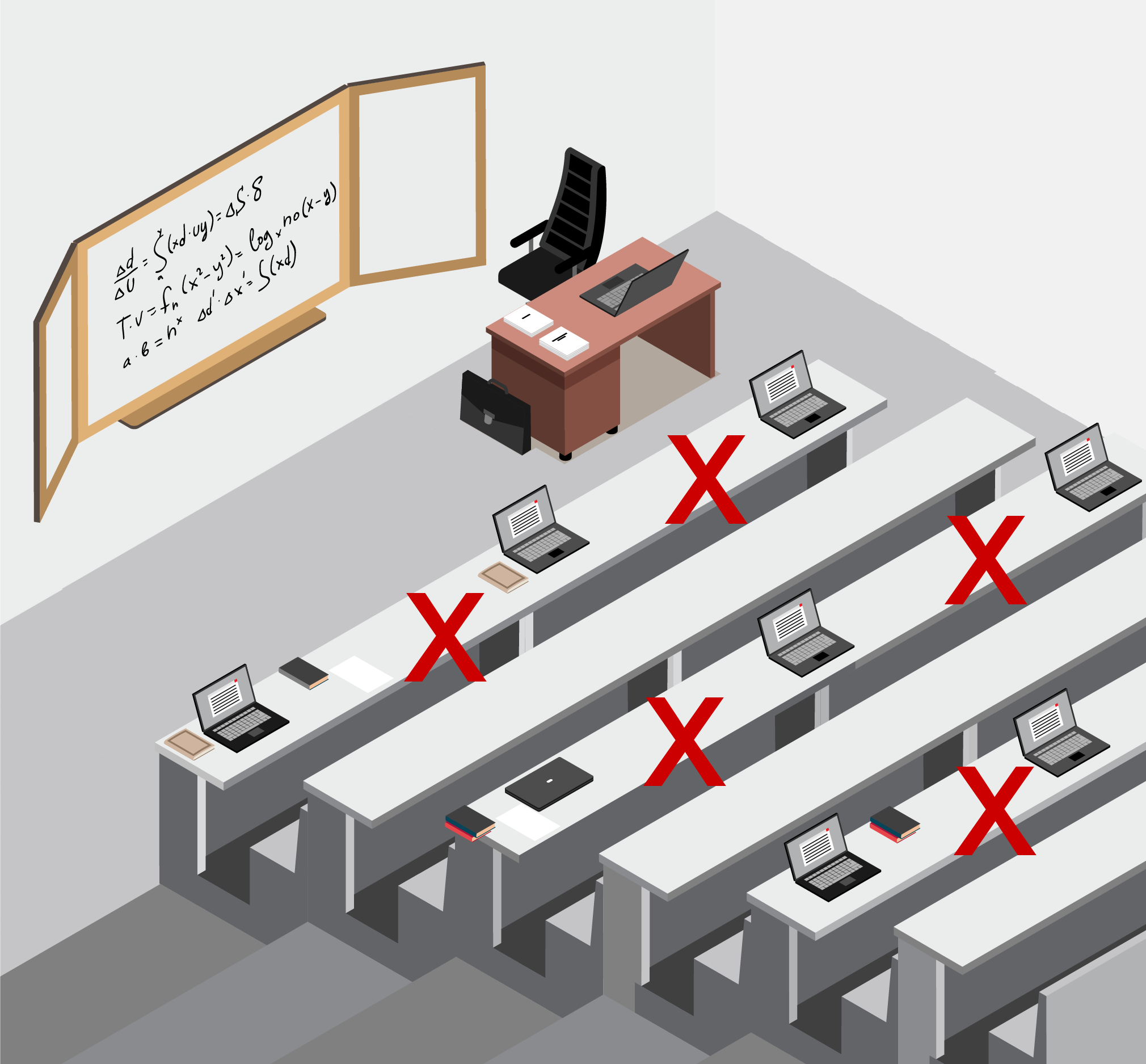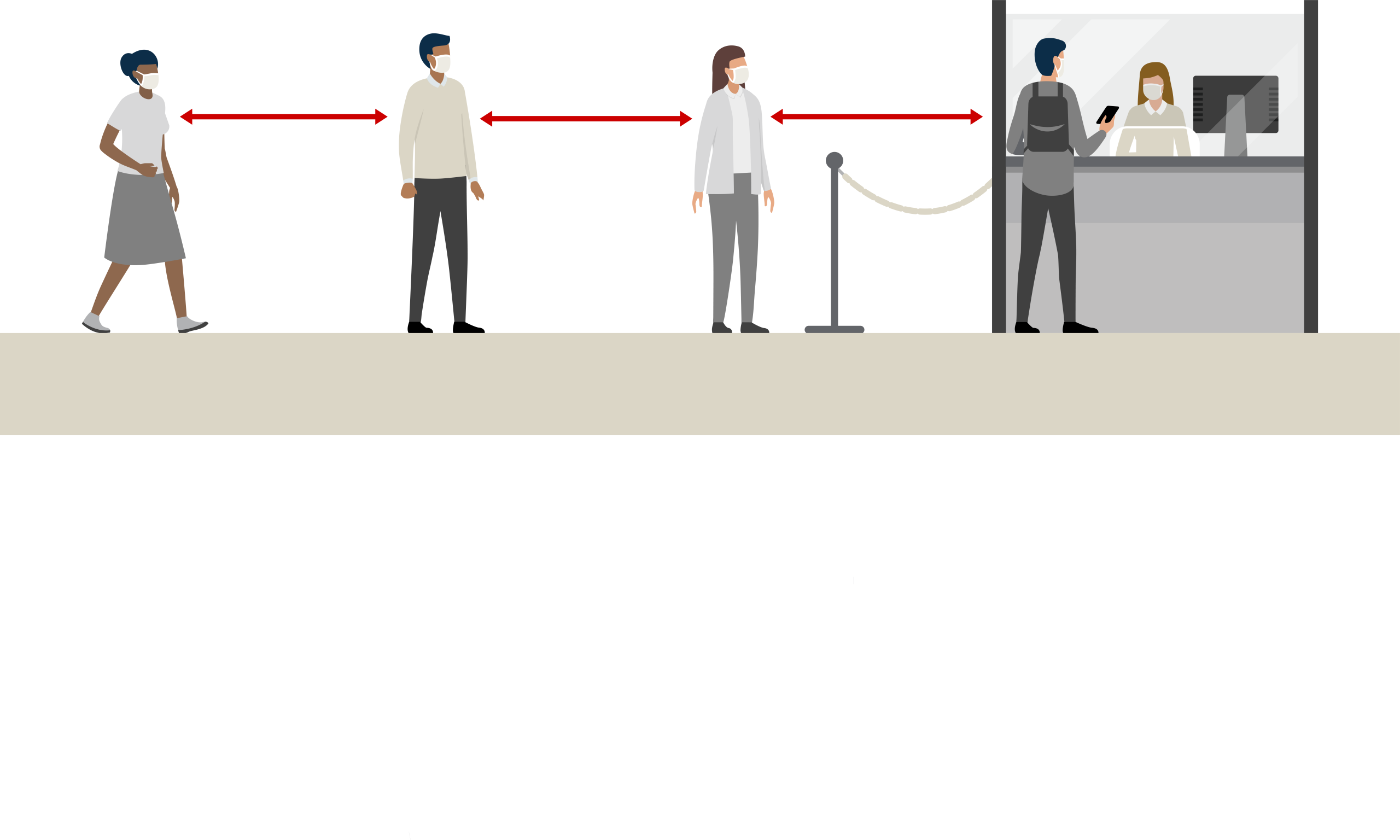(re)open:
A guide for planning and preparing your campus

In the wake of the novel coronavirus pandemic, uncertainty hovers. Testing continues to be limited, while a vaccine may be more than a year away. As higher education institutions plan to re-open for the 2020-2021 academic year, major questions remain: How do you prepare for the return of students, faculty and staff to your campus? Once they arrive, how will you manage your residence halls, dining halls, classrooms and offices, and serve your mission in a challenging fiscal environment?
Despite some relief from the U.S. Coronavirus Aid, Relief and Economic Security (CARES) Act, the $14 billion allocated to higher education has been broadly viewed as inadequate. In addition, state funding for higher education is likely to decline as a result of reduced state tax revenues and budget shortfalls.
Even in a best-case pandemic scenario, higher education revenue loss may reach as much as 20% for the 2020-21 school year, with an estimated additional 20% loss for state universities because of reduced state tax revenues and increased budget shortfalls.
While many students are completing their academic year through virtual learning, your institution may have had to refund room and board fees and is likely losing revenue streams from food service, campus rentals, activity fees, campus events and lower endowment returns. Looking to fall, enrollment uncertainty looms.
The bottom line? Drastically reduced short-term and long-term funding for capital projects, ongoing operations and the mission of education—not just this fiscal year, but for the next several years.
Advancing beyond “business as usual”
To succeed in the post-pandemic era, your institution is undoubtedly considering a range of scenarios for balancing the mission of providing a high-quality education with the need to remain financially sustainable. For a look at strategies that other institutions are exploring, visit The Chronicle of Higher Education’s ongoing list of institutions planning to reopen in fall 2020.
Some universities and colleges have already announced plans to delay the fall semester start or to remain online-only for at least part of the fall. Some are block-scheduling classes in shorter segments to allow for in-person or online learning. Many are likely to land in the hybrid model of offering the in- person campus experience modified by daily social distancing and other practices. Numerous colleges and universities have extended their acceptance deadlines as they determine how best to proceed in the context of evolving government mandates and public health updates.
Whatever scenario fits your institution, you will need to explore new avenues to do more with less. According to The Chronicle of Higher Education, 96% of colleges and universities are looking to re-engineer processes and look for efficiencies. Looking beyond administrative cost reductions, colleges and universities will be pressed to find new ways to advance their missions, operate more efficiently and generate revenue, and develop more agile and resilient organizational strategies.

Prepare to reopen
In the immediate future, you’ll need to determine how best to incorporate social distancing and sanitation strategies into your classrooms, dining halls, athletics, administrative offices and other campus facilities. You’ll need to consider new staffing, teaching, research and even student housing models, along with health-focused standard operating procedures (SOPs) and possibly smart building technologies that enable virtual collaboration, improve air quality and support educational and administrative activities.
The following are key areas to consider to create a safe and productive campus for all stakeholders.
- Ensure the health and wellness of your students, faculty, staff and visitors.
Before your faculty, staff and students return to the campus, you must develop new SOPs and policies to ensure safety, security, productivity and wellness on campus. These new practices will encompass a myriad of issues beyond social distancing, including use of protective gear, cleaning protocols, classroom management and campus visitor screening protocols. And, you may need to engage your labor representatives to establish agreement on new standards and policies.
Also, you’ll need faculty and staff training to adjust to new campus behaviors, communicate expectations and drive adherence to new protocols. Information and guidance for students and their parents also will be essential. For example, many campuses aim to implement testing and temperature screening to the extent possible for faculty, staff, students and visitors—one university is considering a body temperature scanner to screen visitors before entering large academic buildings, the student center and health center. Contact tracing is another possibility of which stakeholders should be made aware.
While assessing different operating scenarios, college and university administrators are considering creative policies to build social distancing into their campuses. Some are as simple as establishing one-way foot-traffic lanes to reduce crowding and collisions on walkways, hallways and other shared spaces. Others will require more significant effort.

The following are some emerging strategies for incorporating social distancing into daily campus life.
Classrooms and lecture halls: Some institutions are planning to limit occupancy in large lecture halls to allow for empty seats and rows between students, while enabling students to rotate in-person attendance with virtual attendance. Another approach is to record faculty lectures for students to “attend” on their own, with smaller group classes in which professors provide help with homework assignments. Classrooms, in turn, may require reconfiguration to move desks and chairs six feet apart.
Some colleges and universities are extending classroom use by several hours per day to accommodate more reduced class size. If a particular faculty member or class is in high demand, some classes potentially could be offered more frequently to accommodate a reduced class size. Night programs are another way to extend the day, while optimizing use of academic spaces.
Student life: As detailed in an editorial in The New York Times by Christina Paxson, president of Brown University, traditional aspects of collegiate life—including parties, athletic events, concerts—could continue, but with participants watching online or seated far apart in person.
Many colleges and universities are planning to limit student housing to single occupancy, augmenting campus housing with hotels or nearby apartment buildings to accommodate the single-occupancy limit or isolate students diagnosed with COVID-19.
Another common approach is to limit on-campus student housing to first-year and fourth-year students. Athletic events may take place amidst empty stands, with fans online. Or, you may choose to close some facilities or activity spaces altogether to protect campus health.
Dining halls: Given the challenge of managing social distancing and constant sanitation in a large dining hall, some colleges and universities are choosing to limit campus food service to take-out only. Other approaches including scheduling students in shifts to avoid crowds, along with removing tables and chairs to create more space between diners. Don’t overlook policies for smaller dining operations, such as the on-campus Starbucks, that are popular with students.

Classrooms: Reconfigure desks and chairs to accommodate social distancing. Implement controlled circulation, ingress, and egress for classrooms using visual cues to support social distancing. Enhance standards and frequency of custodial.
Classrooms: Reconfigure desks and chairs to accommodate social distancing. Implement controlled circulation, ingress, and egress for classrooms using visual cues to support social distancing. Enhance standards and frequency of custodial.

Lecture halls: Limit total occupancy of lecture halls to ensure social distancing. Keep students seated facing the same direction instead of facing each other. Implement controlled circulation, ingress, and egress for classrooms using visual cues to support social distancing. Enhance standards and frequency of custodial.
Lecture halls: Limit total occupancy of lecture halls to ensure social distancing. Keep students seated facing the same direction instead of facing each other. Implement controlled circulation, ingress, and egress for classrooms using visual cues to support social distancing. Enhance standards and frequency of custodial.
Administrative offices: During this period of self-isolation, many higher education staff have been working from home—unless they’re on the front lines fighting the virus in a university medical center. For many working at home, shelter-in-place required a quick study in using virtual technologies for teaching, collaboration and administrative meetings. For a safe, productive fall, you may need to formalize teleworking policies and rotate staff in and out of the office to provide social distancing. Also, staff may require new technologies and training to improve communication and productivity in your post-pandemic campus. And, you may need to adapt your office floorplans to allow for appropriate social distancing for those physically present.
- Ensure that your buildings are safe, resilient and ready
Every member of your campus community will naturally be highly sensitive to disinfection and protective protocols, including the availability of masks and gloves, and policies for maintaining social distancing. You’ll need to develop plans and procedures to keep buildings and learning spaces safe for live-work-study-play activities, and to communicate these changes to faculty, staff, students, parents and visitors. Both NACUBO and APPA offer extensive information—including guidelines and examples of successful and emerging practices—that can help inform practices at your campus (see resource links below).
Increased janitorial support will be essential to ensure that classrooms, laboratories, study rooms, dining halls and other common areas are disinfected after every use, and that bathrooms are continually cleaned. One time-saving option is to adopt new materials, such as self-cleaning elevator buttons and door-handle sleeves or adhesive skins, that continuously disinfect high-touch surfaces. In classrooms, one option is to provide disinfectant wipes that students can use to clean their seating areas themselves. In aging buildings, you’ll need to monitor and manage air quality to reduce airborne risk. And, you’ll need sanitation SOPs in the event that a faculty or staff member, or a student, is diagnosed with COVID-19.
- Create and monitor effective guidelines and adjustments to your space
Even with a number of precautions in place to ensure the safety and health of your campus stakeholders, unforeseen issues will undoubtedly arise as space is re-occupied. Maintaining a safe campus will require a high level of onsite supervision and stakeholder feedback, and a nimble mindset so your team can quickly modify and adopt policies and practices informed by actual workplace usage.

Campus entrances: Consider student, faculty, administration and visitor screening. Add visual cues to support social distancing. Amend mail service.
Campus entrances: Consider student, faculty, administration and visitor screening. Add visual cues to support social distancing. Amend mail service.

Residence halls: Consider single occupancy rooms. Implement campus housing foot traffic management and signage. Use preventative, reactive and decontamination cleaning and enhance standards and frequency. Consider well-being toolkit.
Residence halls: Consider single occupancy rooms. Implement campus housing foot traffic management and signage. Use preventative, reactive and decontamination cleaning and enhance standards and frequency. Consider well-being toolkit.
Looking ahead
Long after the current crisis, dramatic budget shortfalls will require every university or college to become more agile, resilient and innovative. The evolution of the postpandemic higher education institution will require a holistic view of your stakeholders, real estate and the technology you use to manage your real estate and pursue your mission.
The first step will be to examine lessons learned and new practices adopted during the pandemic and the early stages of returning to campus despite the continuing threat of the novel coronavirus. Following the rapid shutdown of campuses this spring, you now have foundational practices in place.
To thrive over the long term in the post-pandemic era, the following are key areas to consider:
- Create a flexible operating model
In the face of severely constrained budgets and continuing needs for higher education, you’ll need to creatively assess how best to leverage the core skills required to support your institution’s mission. For instance, some colleges and universities are exploring the variable labor model, in which non-core services are performed by variable private sector labor while fulltime employees focus on delivery of complex core services.
Many organizations are adjusting staff schedules to reduce the number of people in circulation on campus. Building engineers or data center administrators could, for instance, work three or four 12-hour days followed by several days off.
- Adopt future-fit education and real estate strategies
Few higher education institutions will remain just as they were before the pandemic. If retained, some practices adopted for re-opening can provide sustained cost savings and other benefits over time.
In your administrative offices, for instance, continued use of teleworking could help reduce your administrative footprint and occupancy costs.
Concurrently, these adaptations will help you improve organizational agility, while assuring stakeholders that your classrooms, laboratories, residence hall rooms and offices are clean, effective and safe.
Even within budget constraints, your campus will still need capital investment.
One strategy for financing those investments is to create long-term public-private partnerships (P3s), in which a private sector partner assumes responsibility for developing and operating a facility while your institution retains control. P3s can enable you to monetize selected real estate assets, upgrade utilities or offload deferred maintenance, creating additional revenues to direct toward your mission.
- Leverage technology to help ensure safety and reduce costs
In the post-pandemic world, technology can help you address the competing demands of providing safe, productive classrooms and workspaces and cost-effectively serving stakeholders. Today’s facility management technology can integrate floorplans, building information, classroom scheduling and shared space bookings, enabling efficient space management as well as rapid response to new COVID-19 cases on campus. With this level of coordination, your facility managers can quickly identify and notify affected stakeholders and flag the affected space for cleaning protocols.
For example, you can adopt intelligent mobile apps to streamline everyday tasks for students, faculty and staff. With a campus mobile app, students, faculty and staff could quickly initiate contactless food delivery, order cleaning services, and make room bookings backed by algorithms that automatically build in social distancing requirements and sanitation time.
In addition, facility management technology can help you centralize classroom planning, optimize use of classrooms and sidestep the need for additional academic space should enrollment increase in the future. Occupancy planning tools can be used to efficiently manage space usage across multiple campus facilities. Using real-time WiFi login and security badge data, as well as data from heat and motion sensors, you can analyze space utilization activity to understand how and when faculty, staff and students are using campus facilities. And, you can easily monitor building activity to ensure that your facilities don’t exceed post-pandemic capacity limits. These technologies, coupled with predictive analytics tools, can also provide data-driven insights for right-sizing your real estate footprint—and drive down real estate costs over time.


Adapting to the new normal
For higher education institutions, the new normal will last into the indefinite future. In the short term, while the virus is still a threat, colleges and universities will need take to steps to help students, faculty and staff work safely. However, the negative economic impacts of COVID–19 are likely to last for years. It will be critical for higher education organizations to do more with less over the foreseeable future.
Institutions will need to reimagine their educational delivery systems with new methodologies that costeffectively provide high-quality education while leveraging physical and virtual teaching platforms.
Since real estate and facilities are one of the largest expenses for colleges and universities, finding ways to reduce its cost will be essential.
Adapting for the long term will require a holistic view of your institution’s real estate portfolio, enabling you to evaluate the interrelationships between your stakeholders, the spaces they use, and the technologies available to help manage the use of your campus facilities.
Throughout, the lessons learned during the pandemic can inform your planning for today and the future. By taking key steps today, you can begin to reimagine how best to serve the mission of education and thrive in the postpandemic future.
For more information, talk to a JLL professional
Contact us to learn how we can help you navigate the steps necessary to reopen your campus: +1 (312) 940-6848
Higher Education COVID-19 Resources:



